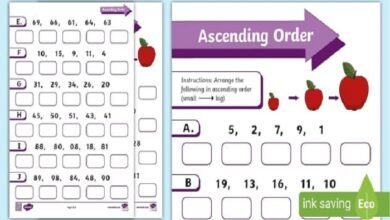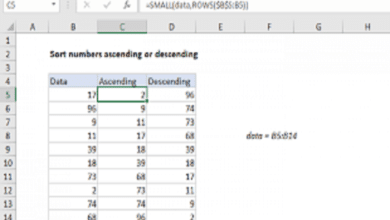Ascending Order in Numbers: A Comprehensive Guide

Introduction
Ascending order in numbers is a fundamental concept in mathematics and data organization. It involves arranging numbers from the smallest to the largest, a process that is crucial in various fields, including computer science, finance, and everyday life. In this blog post, we will delve into the importance of ascending order, explore different methods of sorting numbers, and understand its applications through practical examples.
What is Ascending Order in Numbers?
Ascending order in numbers refers to arranging a set of numbers from the smallest to the largest. This order makes it easier to analyze data, identify patterns, and perform calculations. For example, arranging the numbers 3, 1, 4, and 2 in ascending order results in 1, 2, 3, and 4.
Importance of Ascending Order
Understanding ascending order in numbers is essential for various reasons. It simplifies data comparison, aids in statistical analysis, and enhances the readability of data. In real-life scenarios, such as organizing financial statements or arranging dates chronologically, ascending order plays a crucial role in ensuring accuracy and efficiency.
Methods of Sorting Numbers in Ascending Order
There are several methods to sort numbers in ascending order, including:
- Manual Sorting: Useful for small sets of numbers, where each number is compared and arranged sequentially.
- Bubble Sort: A simple algorithm that repeatedly steps through the list, compares adjacent elements, and swaps them if they are in the wrong order.
- Selection Sort: This algorithm divides the list into a sorted and an unsorted region, repeatedly selecting the smallest element from the unsorted region and moving it to the sorted region.
- Insertion Sort: Builds the final sorted list one item at a time, inserting each new element into its proper place.
- Quick Sort and Merge Sort: More advanced algorithms used for larger datasets, providing efficient sorting mechanisms.
Manual Sorting of Numbers
Manual sorting is a straightforward method for arranging small sets of numbers in ascending order. For instance, if we have the numbers 8, 3, 5, and 1, we can manually compare each number and rearrange them to get 1, 3, 5, and 8. This method, while simple, becomes impractical for larger datasets.
Bubble Sort Algorithm
The bubble sort algorithm is a basic yet effective method for sorting numbers in ascending order. It works by repeatedly comparing adjacent numbers and swapping them if they are in the wrong order. This process continues until the entire list is sorted. For example, sorting the numbers 4, 2, 9, and 1 using bubble sort involves multiple iterations to achieve the final sorted order of 1, 2, 4, and 9.
Selection Sort Algorithm
Selection sort is another technique for arranging numbers in ascending order. It works by dividing the list into a sorted and an unsorted region. The algorithm repeatedly selects the smallest number from the unsorted region and moves it to the sorted region. This process is repeated until all numbers are sorted. For instance, sorting the numbers 7, 5, 2, and 6 using selection sort will result in the ascending order of 2, 5, 6, and 7.
Insertion Sort Algorithm
Insertion sort builds the final sorted list one number at a time. It picks each number from the unsorted list and inserts it into the correct position in the sorted list. For example, sorting the numbers 3, 1, 4, and 2 using insertion sort involves inserting 1 before 3, resulting in 1, 3, 4, and 2, and then finally inserting 2 in its correct position to get 1, 2, 3, and 4.
Advanced Sorting Algorithms: Quick Sort and Merge Sort
Quick sort and merge sort are advanced algorithms used for sorting large datasets in ascending order. Quick sort works by selecting a ‘pivot’ element and partitioning the other elements into two sub-arrays, according to whether they are less than or greater than the pivot. Merge sort divides the list into two halves, sorts them, and then merges them back together. These algorithms are highly efficient for handling large amounts of data.
Applications of Ascending Order in Real Life
Ascending order in numbers is applied in various real-life scenarios. In finance, it helps in organizing transaction records, sorting account balances, and preparing financial statements. In technology, it is used in algorithms for searching and data retrieval. Ascending order is also crucial in academic settings for grading systems, where scores are arranged from the lowest to the highest to determine rankings.
Practical Examples of Ascending Order
To understand the practical application of ascending order, consider the following example: A teacher needs to arrange student grades in ascending order to identify the lowest and highest scores. If the grades are 85, 72, 93, and 66, arranging them in ascending order results in 66, 72, 85, and 93. This arrangement helps in analyzing student performance and making informed decisions.
Conclusion
Mastering the concept of ascending order in numbers is essential for anyone working with data. From basic manual sorting to advanced algorithms like quick sort and merge sort, understanding how to arrange numbers in ascending order is a valuable skill. Its applications in finance, technology, and education demonstrate its importance in organizing and analyzing data effectively.
FAQs
1. What is ascending order in numbers? Ascending order in numbers refers to arranging a set of numbers from the smallest to the largest.
2. Why is ascending order important? Ascending order simplifies data comparison, aids in statistical analysis, and enhances the readability of data.
3. What are some methods for sorting numbers in ascending order? Methods include manual sorting, bubble sort, selection sort, insertion sort, quick sort, and merge sort.
4. How does the bubble sort algorithm work? Bubble sort repeatedly compares adjacent numbers and swaps them if they are in the wrong order, continuing until the entire list is sorted.
5. Where is ascending order used in real life? Ascending order is used in finance for organizing transaction records, in technology for data retrieval algorithms, and in education for grading systems.



